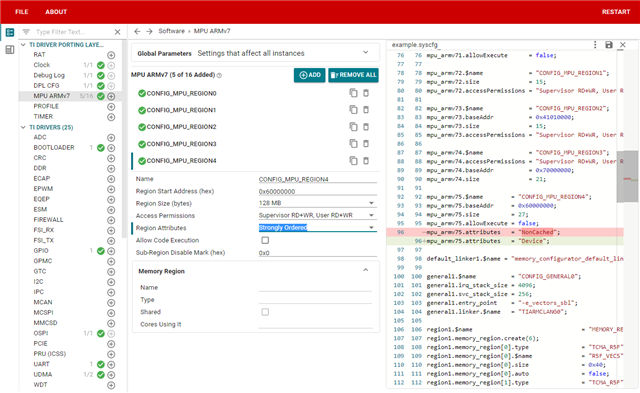主题中讨论的其他器件:SysConfig、 UNIFLASH
工具与软件:
您好、TI 专家!
我正在尝试修改 SBL、以将固件(XIP 格式)写入闪存。
SDK 版本为 MCU+ SDK v10.00.00.20。
我在这里有两个问题、如果你能回答、我将不胜感激。
我无法在 SBL 过程中写入闪存。 (Flash_WRITE()的返回值为错误。)
我采取的步骤如下。
1.我从 SBL 示例中删除了固件读取过程[*1]并添加了闪存写入过程。
2.我参考了 OSPI 示例[*2]的闪存写入过程。
*1: examples/drivers/boot/sbl_ospi.
*2: examples/ospi/ospi_flash_io
生成的源代码(main.c)如下所示。
闪存写入过程从第135行开始。
/*
* Copyright (C) 2018-2022 Texas Instruments Incorporated
*
* Redistribution and use in source and binary forms, with or without
* modification, are permitted provided that the following conditions
* are met:
*
* Redistributions of source code must retain the above copyright
* notice, this list of conditions and the following disclaimer.
*
* Redistributions in binary form must reproduce the above copyright
* notice, this list of conditions and the following disclaimer in the
* documentation and/or other materials provided with the
* distribution.
*
* Neither the name of Texas Instruments Incorporated nor the names of
* its contributors may be used to endorse or promote products derived
* from this software without specific prior written permission.
*
* THIS SOFTWARE IS PROVIDED BY THE COPYRIGHT HOLDERS AND CONTRIBUTORS
* "AS IS" AND ANY EXPRESS OR IMPLIED WARRANTIES, INCLUDING, BUT NOT
* LIMITED TO, THE IMPLIED WARRANTIES OF MERCHANTABILITY AND FITNESS FOR
* A PARTICULAR PURPOSE ARE DISCLAIMED. IN NO EVENT SHALL THE COPYRIGHT
* OWNER OR CONTRIBUTORS BE LIABLE FOR ANY DIRECT, INDIRECT, INCIDENTAL,
* SPECIAL, EXEMPLARY, OR CONSEQUENTIAL DAMAGES (INCLUDING, BUT NOT
* LIMITED TO, PROCUREMENT OF SUBSTITUTE GOODS OR SERVICES; LOSS OF USE,
* DATA, OR PROFITS; OR BUSINESS INTERRUPTION) HOWEVER CAUSED AND ON ANY
* THEORY OF LIABILITY, WHETHER IN CONTRACT, STRICT LIABILITY, OR TORT
* (INCLUDING NEGLIGENCE OR OTHERWISE) ARISING IN ANY WAY OUT OF THE USE
* OF THIS SOFTWARE, EVEN IF ADVISED OF THE POSSIBILITY OF SUCH DAMAGE.
*/
#include <stdlib.h>
#include "ti_drivers_config.h"
#include "ti_drivers_open_close.h"
#include "ti_board_open_close.h"
#include <drivers/sciclient.h>
#include <drivers/bootloader/soc/bootloader_soc.h>
#include <drivers/bootloader.h>
#include <kernel/dpl/ClockP.h>
#define DELAY_SEC (1000U)
#define APP_OSPI_FLASH_OFFSET_BASE (0x200000U)
#define APP_OSPI_DATA_SIZE (2048)
static uint8_t gOspiTxBuf[APP_OSPI_DATA_SIZE];
void flashFixUpQspiBoot(void);
void ospi_flash_io_fill_buffers(void);
/* call this API to stop the booting process and spin, do that you can connect
* debugger, load symbols and then make the 'loop' variable as 0 to continue execution
* with debugger connected.
*/
void loop_forever(void)
{
volatile uint32_t loop = 1;
while(loop)
;
}
int main(void)
{
int32_t status;
Bootloader_profileReset();
Bootloader_socWaitForFWBoot();
#ifndef DISABLE_WARM_REST_WA
/* Warm Reset Workaround to prevent CPSW register lockup */
if (!Bootloader_socIsMCUResetIsoEnabled())
{
Bootloader_socResetWorkaround();
}
#endif
Bootloader_profileAddProfilePoint("SYSFW init");
if (!Bootloader_socIsMCUResetIsoEnabled())
{
/* Update devGrp to ALL to initialize MCU domain when reset isolation is
not enabled */
Sciclient_BoardCfgPrms_t boardCfgPrms_pm =
{
.boardConfigLow = (uint32_t)0,
.boardConfigHigh = 0,
.boardConfigSize = 0,
.devGrp = DEVGRP_ALL,
};
status = Sciclient_boardCfgPm(&boardCfgPrms_pm);
Sciclient_BoardCfgPrms_t boardCfgPrms_rm =
{
.boardConfigLow = (uint32_t)0,
.boardConfigHigh = 0,
.boardConfigSize = 0,
.devGrp = DEVGRP_ALL,
};
status = Sciclient_boardCfgRm(&boardCfgPrms_rm);
/* Enable MCU PLL. MCU PLL will not be enabled by DMSC when devGrp is set
to Main in boardCfg */
Bootloader_enableMCUPLL();
}
Bootloader_socOpenFirewalls();
Bootloader_socNotifyFirewallOpen();
System_init();
Bootloader_profileAddProfilePoint("System_init");
Drivers_open();
Bootloader_profileAddProfilePoint("Drivers_open");
#if 0
DebugP_log("\r\n");
DebugP_log("Starting OSPI Bootloader ... \r\n");
#endif
/* ROM doesn't reset the QSPI flash. So do a flash reset */
flashFixUpQspiBoot();
status = Board_driversOpen();
DebugP_assert(status == SystemP_SUCCESS);
Bootloader_profileAddProfilePoint("Board_driversOpen");
status = Sciclient_getVersionCheck(1);
Bootloader_profileAddProfilePoint("Sciclient Get Version");
#if (1)
// Flash writing process based on ospi_flash_io exmaple code.
uint32_t block;
uint32_t page;
uint32_t offset = APP_OSPI_FLASH_OFFSET_BASE;
if(SystemP_SUCCESS == status) {
// Erase block
ospi_flash_io_fill_buffers();
DebugP_log("Erase Flash (%x)...", offset);
Flash_offsetToBlkPage(gFlashHandle[CONFIG_FLASH0], offset, &block, &page);
DebugP_log("block=[%x], page=[%x]\r\n", block, page);
status = Flash_eraseBlk(gFlashHandle[CONFIG_FLASH0], block);
}
if (status == SystemP_SUCCESS) {
// Write
DebugP_log("Writing to Flash (src: %p, dst: %x)...", gOspiTxBuf, offset);
ospi_flash_io_fill_buffers();
status = Flash_write(gFlashHandle[CONFIG_FLASH0], offset, gOspiTxBuf, APP_OSPI_DATA_SIZE);
DebugP_log("Done. status=[%d]\r\n", status);
}
#endif
if(status != SystemP_SUCCESS )
{
DebugP_log("Some tests have failed!!\r\n");
}
Drivers_close();
System_deinit();
return 0;
}
void flashFixUpQspiBoot(void)
{
uint32_t gpiobaseAddr, pinnum;
/* Get address after translation translate */
gpiobaseAddr = (uint32_t) AddrTranslateP_getLocalAddr(CONFIG_GPIO0_BASE_ADDR);
pinnum = CONFIG_GPIO0_PIN;
/* Drive the GPIO Pin low to assert the reset signal */
GPIO_pinWriteLow(gpiobaseAddr, pinnum);
ClockP_usleep(DELAY_SEC);
/* Drive the GPIO Pin high to deassert the reset signal */
GPIO_pinWriteHigh(gpiobaseAddr, pinnum);
ClockP_usleep(DELAY_SEC);
}
void ospi_flash_io_fill_buffers(void)
{
uint32_t i;
for(i = 0U; i < APP_OSPI_DATA_SIZE; i++)
{
gOspiTxBuf[i] = i % 256;
}
}
执行结果如下。
DMSC Firmware Version 10.0.8--v10.00.08 (Fiery Fox) DMSC Firmware revision 0xa DMSC ABI revision 4.0 Erase Flash (200000)...block=[8], page=[0] Writing to Flash (src: 70075008, dst: 200000)...Done. status=[-1] Some tests have failed!!
已确认仅运行 OSPI 示例[*2]时、闪存写入过程可以正常工作。
SBL 中错误的原因未知、因此如果您有任何线索、请告诉我。
我想使用引导加载程序模块在每个内核上执行 XIP 操作、
但是、在将 XIP 格式写入闪存时、我应该将.appimage_xip 写入什么地址?
我是否应该将其覆盖到与.appimage 相同的地址?
请告诉我步骤。
此致、
武田太郎

